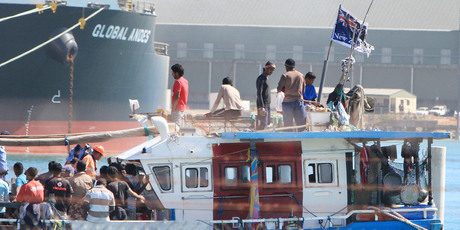Update: Lawlessness and mayhem are back as al-Shabaab attacks the capital—and as our commenters noted earlier.
If it’s a new day and Somalia is on the mend, then WHY ARE WE STILL IMPORTING SOMALI REFUGEES?
If Somalis from the ‘diaspora’ are traveling back and forth to Somalia to buy real estate and do business, why is the flow of “refugees” still moving Westward? Should we even be calling them “refugees” anymore?

Editors note: As of the end of February (5 months into fiscal year 2013) see, here, the US State Department and its contractors have brought 2,814 new Somali “refugees” to the US (read: new Democrat voters and cheap labor)!
In his opinion piece at Insight News, Minnesota Rep. Keith Ellison, the go-to guy for the federal refugee contractors, tells readers how great Somalia is doing and how the US needs to send more money to the country.
Let’s make a deal—send Somalia more money and let them keep their so-called “refugees.”
Ellison (emphasis mine):
It’s a new day in Somalia. That’s the message I took away from a trip to the capital city of Mogadishu earlier this year. We have our best opportunity in more than two decades to help stabilize Somalia and advance U.S. national security interests — but only if we act quickly.
The improved security situation has filled Mogadishu with new life. Somalis can once again play music and dance, activities banned by terrorist group Al-Shabab, which until recently controlled much of the country. Crowds of people fill the streets, socializing and shopping.
Somali-Americans from my district in Minnesota are starting businesses and buying real estate. And a new generation of Somalis from the global diaspora is returning. One of them started Somalia’s first think tank, the Heritage Institute for Policy Studies. Another woman left her high-paying job on Wall Street to help build up Somalia’s financial sector from scratch.
These positive developments are largely a result of Somalia’s successful political transition last year. After many failed attempts, Somali leaders completed a process that produced the first representative, permanent government since the fall of Siad Barre’s regime in 1991.
Somalia now has a new constitution, parliament and president. In a strong vote of confidence, former Secretary of State Hillary Clinton formally recognized the new government when President Hassan Sheik Mohamud visited Washington in January. Mohamud also met with President Obama and more than 20 members of Congress.
Nonetheless, Somalia’s new leaders face challenges that would be difficult even for an experienced, well-resourced government. Ministries are nonexistent or understaffed; there is no public education or established banking system; more than a million people are displaced, and security threats remain serious. However, even the pessimists can no longer say that Somalia is hopeless.
The new government is populated with public servants who want Somalia to succeed. President Mohamud made clear at his meeting on Capitol Hill that security is his top priority. His government must quickly move into areas liberated from Al-Shabab and prove that government can be a force for good, not just a source of corruption and oppression. It can do that by providing basic public services, including trash pickup, transportation, education and a functioning judicial system.
The United States has an opportunity to make an investment in Somalia that could pay huge dividends over time.



